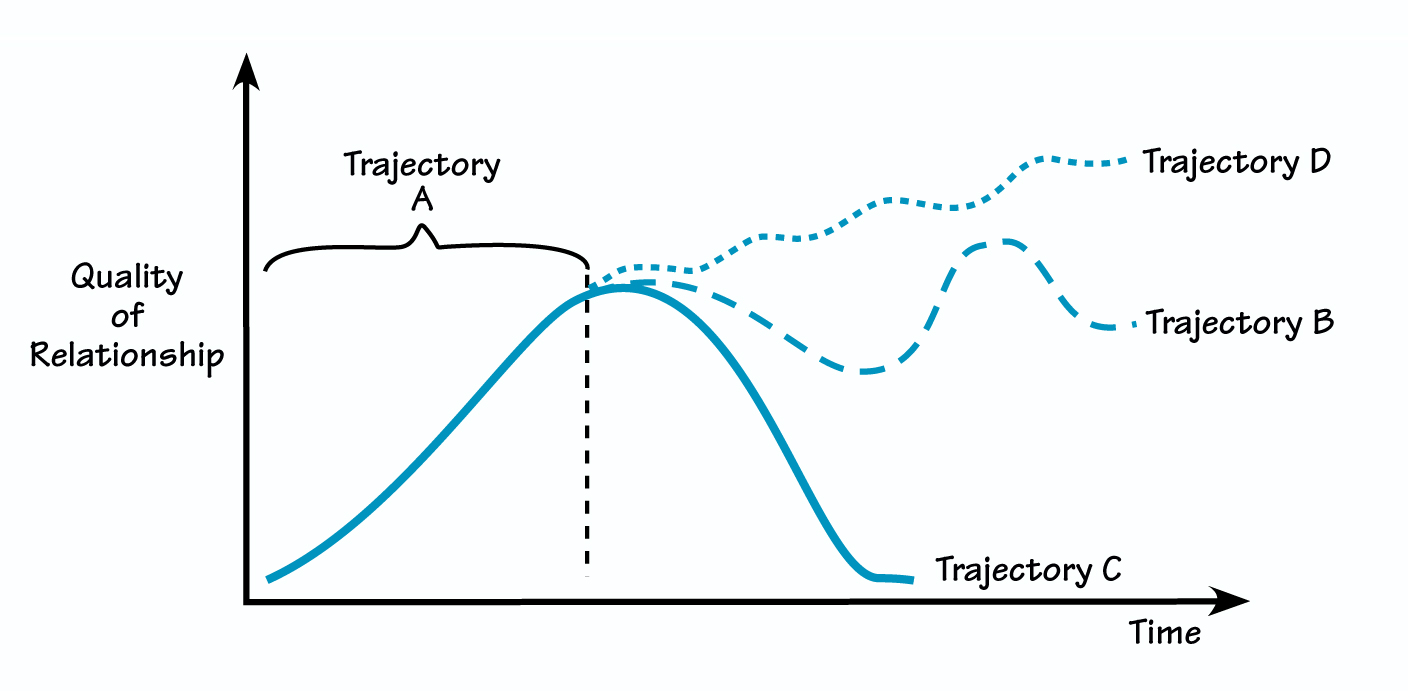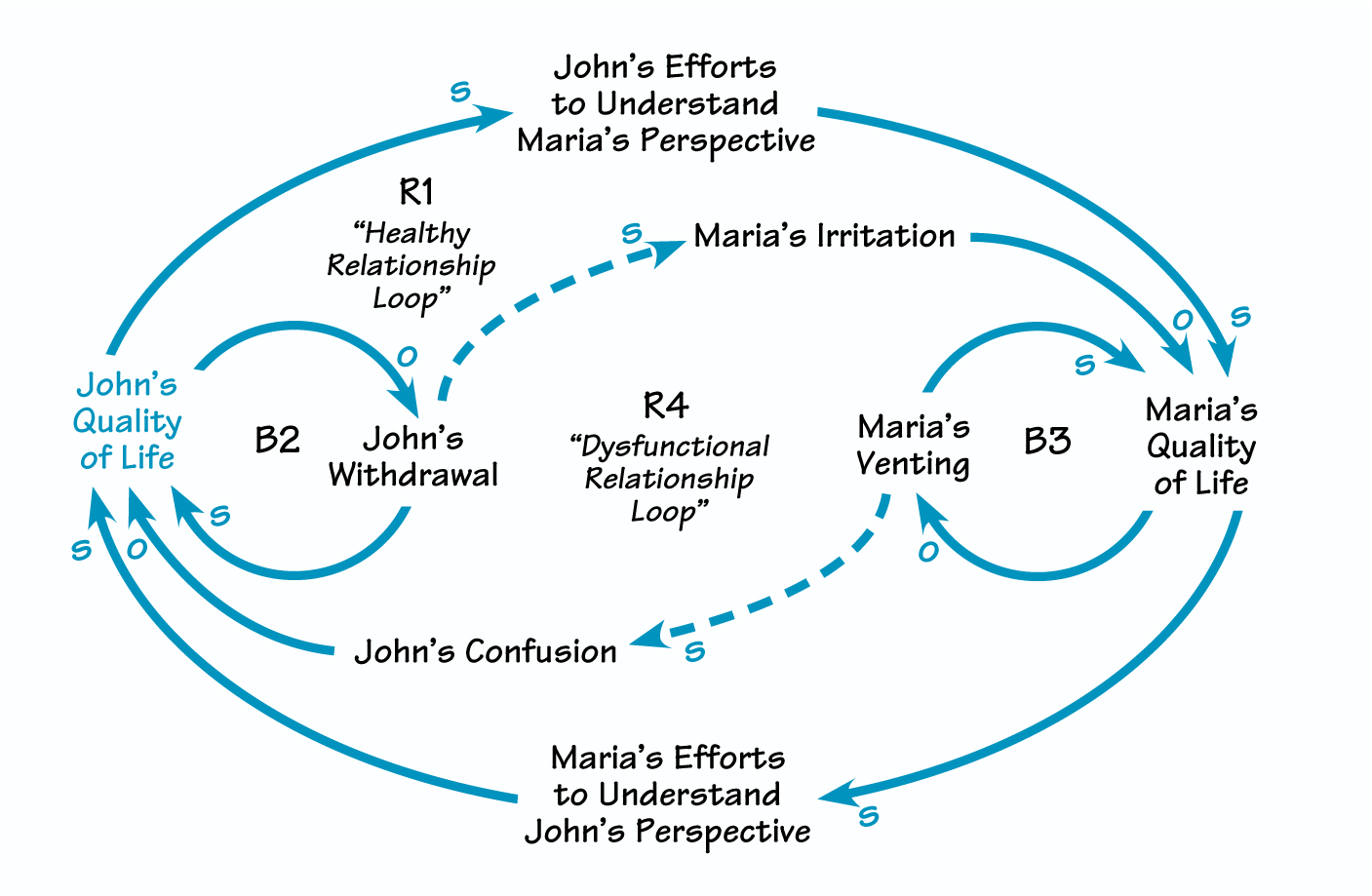Have you ever been in a relationship that you just knew could be better? Or one that required hard work to maintain because of its mercurial ups and downs? The “Accidental Adversaries” systemic structure can help us understand how people, teams, and organizations who should be working in partnership can end up bitterly opposed, despite their best intentions
From the Bedroom . . .
How might two people who view themselves as “playing for the same team” find themselves acting as adversaries? Consider an example from the homefront. Maria and John have been married for five years. As their relationship matured, their levels of intimacy and trust blossomed (see Trajectory A in “The Ups and Downs”). More recently, however, they havebeen riding an emotional roller coaster ride, as indicated by Trajectory B. What is going on?
As shown in “The Accidental Adversaries Trap” on p. 7, this rollercoaster behavior is caused by shifts in the dominance of two reinforcing processes. During the good times, the “Healthy Relationship” loop (R1) is dominant. John and Maria’s quality of life is high, and each acts in ways that contribute to his or her partner’s well-being. When R1 is in full flight, the quality of the relationship heads upward.
THE UPS AND DOWNS

As a relationship matures, the partners’ levels of intimacy blossom (Trajectory A). However, it is easy to slip into an adversarial relationship leading either to an exhausting roller-coaster ride (Trajectory B) or to a break-up (Trajectory C). Trajectory D represents the wobbly—yet continuous—improvement in the relationship that can result from managing the “Accidental Adversaries” dynamic
From time to time, however, Maria or John takes actions that unintentionally disturb the other party. For instance, when faced with stress at home or in the office, John withdraws because it makes him feel better (B2). Maria then becomes irritated by John’s unwillingness to talk through what is on his mind. She copes with the situation by venting her frustration with periodic bursts of anger or tears (B3). However, her outbursts disturb and confuse John, leaving him to wonder what he did wrong. The couple falls into a vicious cycle that undermines the quality of their relationship—the “Dysfunctional Relationship” loop (R4).
If asked to account for the ups and downs of their relationship, John and Maria are likely to give an eventlevel explanation that focuses on specific incidents. The “Accidental Adversaries” structure highlights what is counter-intuitive to them: that their actions contribute to the behavior that they so dislike in their partner. Although they ultimately work things out, the result of this see-saw pattern of behavior is that John and Maria aren’t as close as they would like to be.
The “Healthy Relationship” loop operates while the pair’s behavior is team-centered. As the “Dysfunctional Relationship” loop takes hold, Maria and John both focus more and more on their own quality of life, becoming increasingly self-centered. If R4 were to remain dominant, the quality of the relationship would be thoroughly undermined (Trajectory C in “The Ups and Downs”): Maria and John would have inadvertently become adversaries. If this situation were to persist, they might eventually split up. But because they value their relationship, they have a pattern of regular “clearing the air” spats. These discussions help them to recognize their own contribution to the miserable situation, and lead them to resolve to act differently in the future. Dominance shifts from R4 back to R1, at least for a time.
. . . to the Boardroom
Chances are that you have seen the same dynamics occurring between groups within organizations. For instance, have you noticed how the human resources function in many companies often finds itself in an adversarial role with the groups that it is attempting to support? This service role should be the basis for strong, trusting relationships—so what goes wrong? To map the structure, you might want to redraw “The Accidental Adversaries Trap” with HR in place of John and your own function in place of Maria (you can compare your diagram to the authors’ version at www.pegasuscom.com/hrloop.html).
In the “Healthy Relationship” loop (R1), HR offers high-quality services that contribute to your group’s success. In response, your group relies more heavily on HR, bringing them success and allowing them to extend the range of services they provide. These new offerings help to boost your department’s productivity.
Too often, though, the internal loops of the “Accidental Adversaries” structure (B2, B3, and R4) shape the relationship. HR responds to breaches of regulations that put the company at risk—and threaten their success— by instituting a policy that restricts your group’s autonomy. Your group may believe that this policy interferes with its ability to conduct business— HR should be supporting your initiatives instead of hampering them! The group might side-step the constraints and continue to do what it wants to do. HR then feels even more threatened by your policy breaches, leading them to step up their restrictions. Soon, your departments are trapped in an ongoing power struggle—to the detriment of the organization as a whole.
Out of Adversity
What lessons does the “Accidental Adversaries” structure hold for those wanting to build strong partnerships? Clearly, it is easy to slip into an adversarial relationship leading to either an exhausting roller-coaster ride (Trajectory B) or a break-up (Trajectory C). The challenge is to strengthen the “Healthy Relationship” loop, allowing it to remain dominant
One way to do so is for the parties in a relationship to avoid acting solely in their own interests, instead doing things that contribute to the other person’s success. This selfless approach would mean that John would learn how to talk openly rather than withdraw, and Maria would learn how to handle her frustrations in new ways.
The risk involved is that one party might take advantage of the other. And in many situations, people or departments cannot give up actions that may bring them into conflict with others. For instance, HR cannot ignore regulatory breaches—it must find ways of maintaining constructive relationships with other groups while protecting the interests of the entire company.
More enduring results can come from both encouraging selflessness in the relationship and weakening key links in the “Dysfunctional Relationship” loop (see the dotted arrows in “The Accidental Adversaries Trap”). Managing the relationship involves each party (1) recognizing that the other is going to do things for themselves from time to time, and (2) learning to observe the consequences without assuming bad intent by their partner. This approach allows for some wobble in the relationship without allowing the “Dysfunctional Relationship” loop to become dominant. Trajectory D in “The Ups and Downs” represents the wobbly—yet continuous—improvement in relationships that can result when partners act with insight into this systemic structure.
Strong partnerships are essential for learning. The “Accidental Adversaries” structure illustrates the need to work at building relationships, rather than letting them fall into adversarial conflict by default
THE ACCIDENTAL ADVERSARIES TRAP

During the good times, John and Maria’s quality of life is high, and each acts in ways that contribute to his or her partner’s well-being (R1). However, when faced with stress, John withdraws because it makes him feel better (B2). Maria becomes irritated and copes with the situation by venting her frustration (B3). The couple falls into a vicious cycle that undermines the quality of their relationship (R4).
